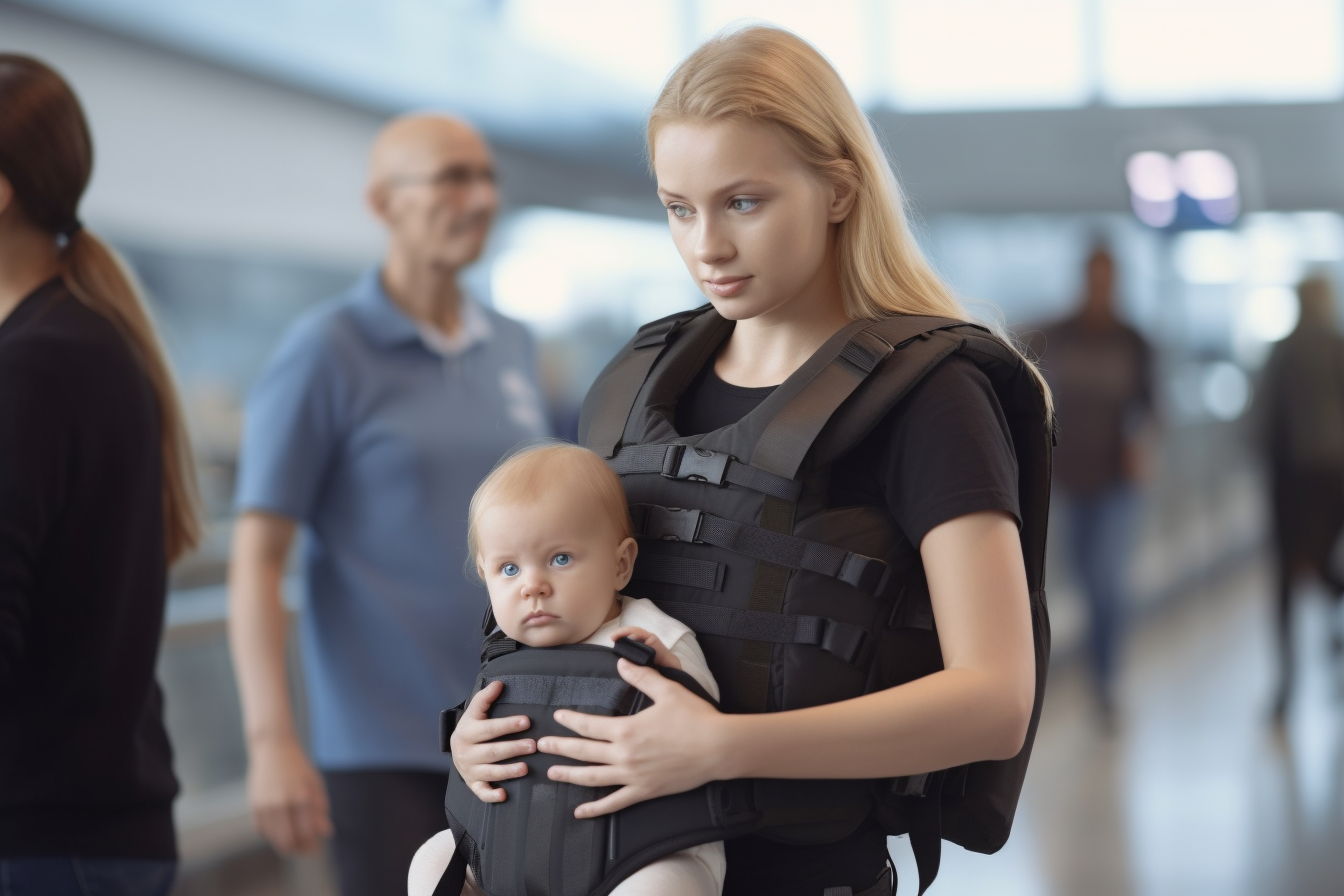Table of Contents
- Flying with a Baby Carrier: Tips for a Smooth Journey
- Airline Regulations for Baby Carriers on Planes
- Choosing the Right Baby Carrier for Travel
- Tips for Using a Baby Carrier During Your Flight
- Safety Considerations when Wearing a Baby Carrier on a Plane
- Which Airlines allow Baby carriers
- Alternatives to Baby Carriers for Air Travel with Infants
- Frequently Asked Questions
- Conclusion
Flying with a Baby Carrier: Tips for a Smooth Journey
Have you ever wondered if it’s possible to wear a baby carrier on a plane? You might have heard rumors that airlines don’t allow it, or that it’s too difficult to navigate through security with a baby strapped to your chest. But the truth is, wearing a baby carrier on a plane can be a great way to keep your little one snuggled up close during a long flight.
In fact, many airlines do allow baby carriers on board, as long as they meet certain regulations. Of course, choosing the right carrier for travel and using it safely during your flight is important to ensure both you and your baby are comfortable and secure.
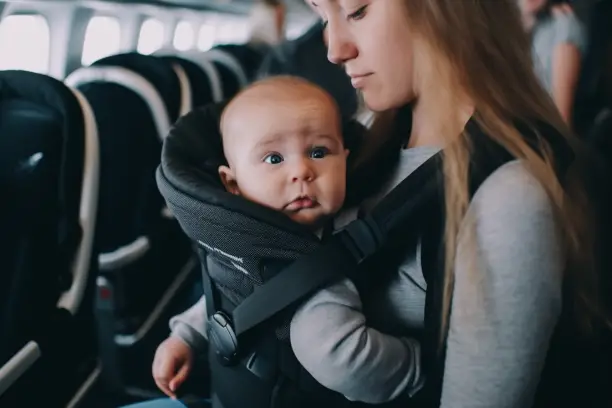
In this article, we’ll explore everything you need to know about wearing a baby carrier on a plane, including airline regulations, carrier options, and safety considerations. So whether you’re a seasoned traveler or a new parent embarking on your first flight with a baby, read on to learn how you can make your journey a little easier and more enjoyable.
Airline Regulations for Baby Carriers on Planes
Airline rules prohibit using certain items during flights, so it’s important to check regulations before boarding.
When it comes to baby carriers, most airlines allow parents to wear them on the plane. However, there are some restrictions you need to be aware of.
Firstly, the baby carrier must be approved by the airline. This means that it must meet certain safety standards and be labeled as FAA or EASA approved. Additionally, some airlines may require that the baby be facing towards the parent during takeoff and landing, and that the carrier is removed during turbulence.
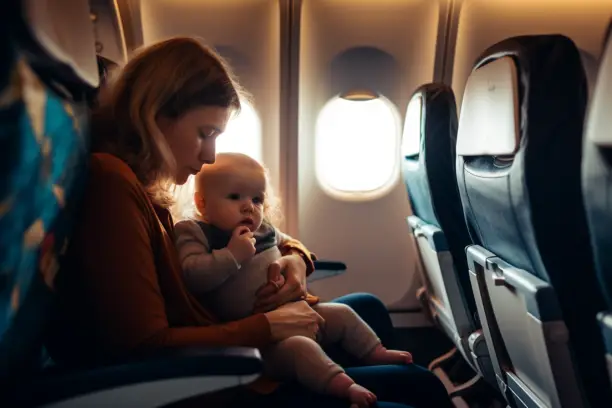
It’s best to check with your airline before your flight to ensure that your carrier meets all necessary requirements. Now, let’s talk about choosing the right baby carrier for travel.
Choosing the Right Baby Carrier for Travel
Selecting the perfect carrier for your travels can make all the difference in your comfort and ease. When choosing a baby carrier for your flight, consider the length of your journey and the age and weight of your child.
A soft-structured carrier, such as a buckle carrier, is a popular choice for air travel as it’s easy to put on and take off at security checkpoints and provides support for your baby’s head and neck during takeoff and landing.
Another option for air travel is a ring sling, which is lightweight and compact for easy packing. However, it may not provide as much support for longer flights or heavier babies.
A mei tai carrier is also a great option as it’s versatile and can be worn in different positions for your comfort and your baby’s needs. Ultimately, the best carrier for your travels is one that fits comfortably and securely, and allows you to have your hands free and move around easily during your flight.
When you’ve chosen the right carrier for your travels, it’s important to know how to use it safely and effectively during your flight. Tips for using a baby carrier during your flight include adjusting the carrier to fit snugly and comfortably, keeping your baby close and secure, and always following airline regulations for takeoff and landing.
With the right carrier and proper use, you and your baby can have a comfortable and stress-free travel experience.
Tips for Using a Baby Carrier During Your Flight
Make your flight with your little one more comfortable and stress-free by learning how to use your baby carrier during air travel.
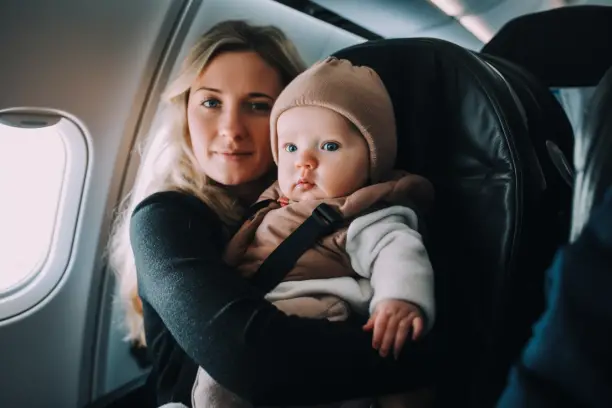
Firstly, consider the type of carrier you choose. A wrap or sling may be more comfortable for both you and your baby during a long flight, as it allows for more flexibility in movement and positioning. However, a structured carrier may be more practical for navigating through security and boarding.
It’s also important to practice using your carrier before your flight to ensure you’re comfortable with the process and can easily get your baby in and out.
During the flight, make sure your baby is in a safe and comfortable position, with their head supported and their airway clear. Be mindful of the amount of time your baby spends in the carrier, taking breaks to allow them to move and stretch.
With these tips in mind, you can make your flight with your baby a more enjoyable experience for both of you.
As you prepare to wear your baby carrier on a plane, it’s important to consider safety considerations. While a carrier can be a convenient way to keep your baby close during a flight, it’s important to follow all airline regulations and safety guidelines.
Ensure that your carrier is properly secured and that your baby is in a safe position at all times. By taking these precautions, you can enjoy the benefits of using a baby carrier during air travel while ensuring the safety of your little one.
Safety Considerations when Wearing a Baby Carrier on a Plane
As you prepare to fly with your little one close to you in a carrier, it’s crucial to keep in mind the safety measures to ensure a comfortable and secure journey.
Firstly, make sure that the carrier you choose is approved by the Federal Aviation Administration (FAA). Some carriers may not meet the safety standards required for air travel, and it’s important to check with the airline beforehand to avoid any issues.
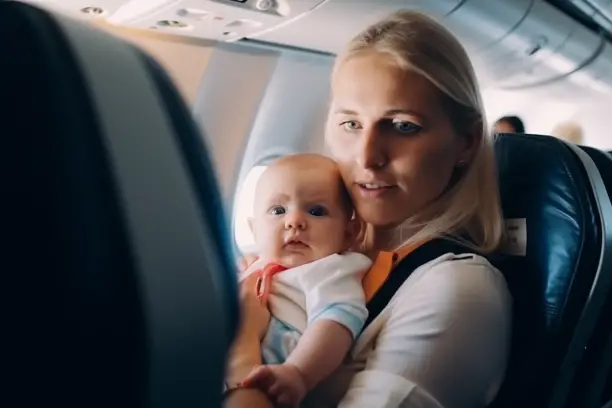
Additionally, ensure that your baby is secure in the carrier and that they are positioned correctly. Avoid placing them in a position that could restrict their breathing, such as facing inward with their chin tucked into their chest. Always follow the instructions provided by the carrier’s manufacturer and check with a flight attendant if you have any concerns.
With these safety considerations in mind, you can enjoy a worry-free flight with your little one by your side.
As you consider the safety of your baby, you may also want to explore alternatives to baby carriers for air travel with infants. While carriers can be a convenient option, some parents prefer to use a stroller or check a car seat for their child. These alternatives offer their own unique benefits and may be worth considering depending on your travel plans and preferences.
Which Airlines allow Baby carriers
Here is a list of airlines that allow baby carriers: ( as per the information that we were able to gather on the Web )
- Air Canada
- Air France
- American Airlines
- British Airways
- Delta Air Lines
- Emirates
- Etihad Airways
- Finnair
- Hawaiian Airlines
- Icelandair
- JetBlue Airways
- KLM Royal Dutch Airlines
- Lufthansa
- Qantas
- Singapore Airlines
- South African Airways
- United Airlines
- Virgin Atlantic
IMPORTANT NOTE : Some airlines put restrictions on the type of baby carrier that is allowed. For example, some airlines only allow carriers that are FAA-approved. It is advised to check with the airline in advance to avoid problems while traveling.
Alternatives to Baby Carriers for Air Travel with Infants
If you’re feeling overwhelmed about keeping your little one safe during air travel, consider exploring other options that may provide you with a sense of ease and comfort. While baby carriers are a popular choice, there are alternatives that may suit your needs better.
Here are some options to consider:
- Strollers: Many airlines allow you to bring a stroller onboard, which can provide a safe and comfortable seat for your infant during the flight.
- Car seats: If your child has their own car seat, you can bring it onboard and use it as a safe and familiar seat for your little one.
- Bassinets: Some airlines offer bassinets that can be attached to the bulkhead seats, providing a safe and comfortable place for your infant to sleep during the flight.
- Baby wraps: If you’re looking for a hands-free option, baby wraps can be a great choice. They allow you to keep your infant close and secure, while still giving you the freedom to move around the cabin.
- Inflatable footrests: If you’re traveling with a lap infant, an inflatable footrest can provide a comfortable and safe place for them to rest during the flight.
By exploring these alternatives, you can find the option that best suits your needs and helps you feel confident and secure during air travel with your little one. Remember to always check with your airline before bringing any equipment onboard, and follow their guidelines for safe and comfortable air travel.
Frequently Asked Questions
Can you wear a baby carrier during takeoff and landing?
During takeoff and landing, it’s generally recommended that you remove your baby carrier and hold your child in your arms. This is the safest way for both you and your baby. However, once the plane has reached cruising altitude, you can usually wear your baby carrier for the duration of the flight.
It’s important to check with your airline beforehand, as each carrier has their own policies and restrictions. Wearing a baby carrier can be a convenient option for parents who want to keep their hands free while traveling with their little one. Just be sure to follow the guidelines provided by your airline and adjust the carrier for a comfortable fit for both you and your baby.
Is there a weight limit for baby carriers on planes?
Did you know that the average weight limit for baby carriers on planes is around 35-40 pounds? It’s important to check with your specific airline as weight limits can vary.
When it comes to traveling with your little one, baby carriers can be a lifesaver for keeping your hands free and your baby close. Not only does it allow for easier navigation through the airport, but it also provides a sense of comfort and security for your child.
But before you board your flight, make sure to check with your airline’s regulations to ensure your carrier meets their requirements. It’s always better to be safe than sorry when it comes to traveling with your little one.
Can you wear a baby carrier in the airport security line?
Going through airport security with a baby carrier can seem daunting, but it’s definitely possible! In fact, wearing your baby in a carrier can make the process much easier and more efficient.
When you reach the security line, simply remove any metal objects from your pockets and place them in a bin along with your shoes and any other items that need to be screened.
Then, with your baby still safely secured in the carrier, step through the metal detector. If the alarm goes off, you may need to undergo additional screening, but this is a quick and painless process.
Overall, wearing a baby carrier through airport security is a great option for parents who want to keep their hands free and their baby close while traveling.
Are there any airlines that do not allow baby carriers on board?
Are you planning to travel with your baby and wondering if you can bring a baby carrier on board?
While most airlines allow baby carriers on planes, it’s important to note that some airlines have specific regulations regarding the use of baby carriers during flight.
For example, some airlines require that the baby carrier be removed during takeoff and landing, while others may allow you to wear your baby throughout the flight.
It’s always best to check with your airline before you travel to ensure that you are aware of their rules and regulations regarding baby carriers on board.
With a little bit of research and preparation, you can ensure a safe and comfortable journey for you and your little one.
Can you breastfeed while wearing a baby carrier on a plane?
Breastfeeding while wearing a baby carrier on a plane is not only possible, but also convenient and comfortable. You’ll be able to keep your hands free and provide your baby with the nourishment they need without taking them out of the carrier.
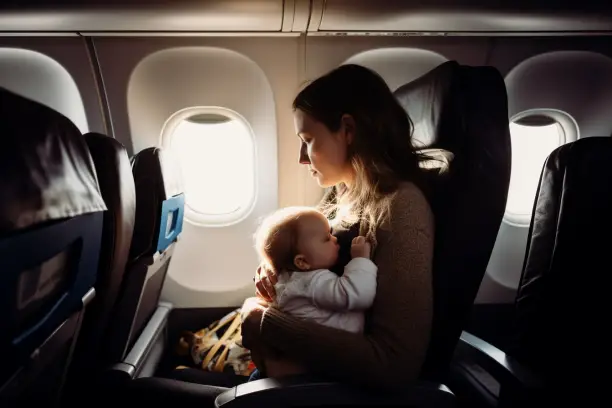
It’s important to keep in mind that some airlines may have specific rules and regulations regarding breastfeeding on board, so it’s always a good idea to check with your airline before your flight.
Additionally, it’s recommended to choose a carrier that provides easy access to your breasts and allows for proper positioning of your baby to ensure a safe and comfortable feeding experience.
Conclusion
So, can you wear a baby carrier on a plane? The answer is yes! However, it’s important to check with your airline’s regulations beforehand to ensure that your carrier is approved for use during the flight.
Once you’ve chosen a carrier that meets the requirements, follow these tips to make your flight more comfortable and safe.
Firstly, choose a carrier that is comfortable for both you and your baby. Look for one with adjustable straps and padding to provide support for your back and shoulders.
Secondly, practice using the carrier before your flight to ensure that you’re comfortable with putting it on and taking it off quickly. Keep in mind that you may need to remove the carrier during takeoff and landing.
Finally, consider bringing a stroller as an alternative option for your baby, especially for longer flights.
In conclusion, wearing a baby carrier on a plane can be a convenient and comfortable way to travel with your little one. Just remember to check airline regulations, choose a comfortable carrier, and practice using it before your flight. By taking these steps, you can ensure a smooth and enjoyable experience for both you and your baby during air travel. Happy flying!

